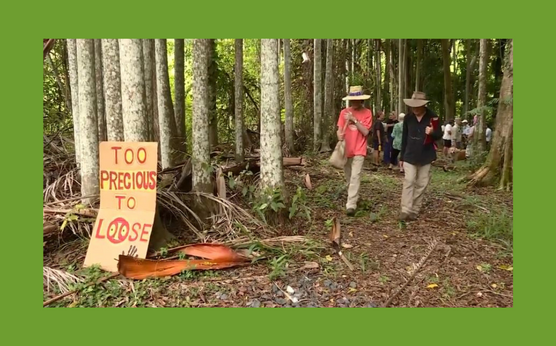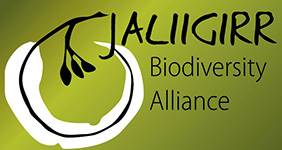
Mackays Road Scrub, The Scrub, Grandpa’s Scrub, the Patch, is a small 0.51 ha remnant of original White Booyong Sub tropical Lowland Rainforest in the West Coffs Harbour basin. It was spared by early pioneer and first settler of the once heavily timbered land, Angus Alexander Mackay, who got permission to retain the patch in order to hold together the loose and vulnerable banks of the Treefern Creek headwaters. The Patch did exactly that and has been valued and cared for by generations of the Mackay family until the property was acquired for the Coffs Harbour Bypass in 2020.
 Driving along the gravel road past the banana plantation on Mackays Road, it is easy to miss this local gem as it hides behind large Camphor Laurel trees and thick vine covered stands of privet and lantana. It is estimated that only 1% of the original lowland rainforest of sub-tropical (STLRF) Australia’s east coast remains, and of that, much is degraded and fragmented. Renowned botanist Alex Floyd regarded STLRF as the most species diverse of all plant communities. STLRF was officially listed as a CEEC (Critically Endangered Ecological Community) by the Scientific Committee in 2011 with quite demanding listing requirements. In recent times the Patch was known by a small handful of locals and some in the bush regeneration fraternity. It was also known and used by some local TAFE teachers to show students as an example of its type.
Driving along the gravel road past the banana plantation on Mackays Road, it is easy to miss this local gem as it hides behind large Camphor Laurel trees and thick vine covered stands of privet and lantana. It is estimated that only 1% of the original lowland rainforest of sub-tropical (STLRF) Australia’s east coast remains, and of that, much is degraded and fragmented. Renowned botanist Alex Floyd regarded STLRF as the most species diverse of all plant communities. STLRF was officially listed as a CEEC (Critically Endangered Ecological Community) by the Scientific Committee in 2011 with quite demanding listing requirements. In recent times the Patch was known by a small handful of locals and some in the bush regeneration fraternity. It was also known and used by some local TAFE teachers to show students as an example of its type.
Despite this the Patch was, and still is, shown on the official Council fine scale vegetation maps as ‘Remnant Native Vegetation’. While the original official flora surveys by RMS working for the Bypass team between 2016 and 2019 did recognize it as a combination of PCT1302 White Booyong and Fig, and PCT670 Black Booyong, Rosewood and Yellow Carabeen; the actual official survey undertaken only investigated a 20m x 20m plot with minimal species diversity and edge exotics including the camphor laurel trees. This survey only found 14 of the necessary 40 woody species and determined the Patch did not meet the listing requirements for a TEC (Threatened Ecological Community.) This allowed TfNSW (Transport for NSW) to avoid referring the Patch to the Commonwealth which is a requirement for Matters of National Environmental Significance under the Environment Protection Biodiversity Conservation Act.

TfNSW Original Concept Plan, Grandpas Scrub indicated in red
It also meant the original planned alignment which cut off the NW corner of the patch and placed an underpass access road through its centre could be claimed as ‘legal’ with sufficient biodiversity offsetting. A large property with mixed vegetation and lowland RF in steep inaccessible gullies was purchased at Upper Kalang many kilometres to the south in the foothills of the escarpment for this purpose.
Despite the Patch being flagged by both public and Council in the 2019 Response to the EIS, no changes were made to spare it, and by 2021 it looked like it was destined for the ‘chop’.
In a last minute attempt to more accurately record the species contained within the Patch and document as much as possible on camera and video before it was destroyed, a public group Facebook page was set up and people were invited to contribute. A campaign of letter writing to politicians and Government agencies followed with calls for the true environmental as well as heritage and cultural value to be recognised. An online petition page was also opened and people invited to sign and share.
 Over this time a variety of citizen scientists, ecologists, and bush regenerators assisted in adding to the knowledge base. An initial list had found over 30 native species with the assistance of renowned rainforest expert Alex Floyd. By mid-2022 over 70 species had been identified and it became evident the Patch could likely meet the listing requirements for a TEC.
Over this time a variety of citizen scientists, ecologists, and bush regenerators assisted in adding to the knowledge base. An initial list had found over 30 native species with the assistance of renowned rainforest expert Alex Floyd. By mid-2022 over 70 species had been identified and it became evident the Patch could likely meet the listing requirements for a TEC.

Auntie Kerrie Burnett and Kevin Mackay
Despite presenting TfNSW with this information in September 2022 they were still adamant the access road could not be moved and the original plan to destroy the Patch in its entirety would stand. This changed however in October 2022 when the local Garlambirla Guuyu-girwaa Aboriginal Elders Corporation made a plea for changes which reflected their connection with the Patch as being a last remaining example of the forests which sustained them here on the coast for tens of thousands of years. Transport then conceded that the access road could be relocated but the main highway which cut off the best part would remain. The concession was that access to adjacent Bypass land would be made available on which rainforest species could be planted and re-vegetated. This Proposition was opposed by local individuals and groups on the grounds that the best portion of species diversity would be lost and the main creek tributary filled in, depriving the remaining vegetation of any viable likelihood of survival.
A ‘Gathering’ of locals, Gumbaynggirr elders and family descendent Kevin Mackay met at the Patch in November to tell the story and find some solace in reflecting on its significance. This event was covered by both print and TV media and launched a public awareness campaign which now put the issue front and centre in the local community.

Acclaimed botanist Dr Rob Kooyman surveys the site
In December, at the last ordinary Council meeting for the year, Councillor Jonathan Cassell put a Notice of Motion to Coffs City Council asking for the Scrub to be protected. With the addition of a positive determination made by visiting renowned RF botanist Dr Rob Kooyman, who surveyed the site on 23rd January whilst in the City for Alex Floyd’s memorial service; plus advice from leading Environmental lawyer and NSW Upper House MLC Sue Higginson raising significant issues with the legality of the planned destruction and offsetting proposal, Transport now had little choice but to listen.

Cr Jonathan Cassell speaking up for ‘Grandpa’s Patch’
On February 17th 2023, with a state election coming up, the NSW Transport Minister Sam Farraway, in conjunction with local member Gurmesh Singh announced a re-alignment of the Highway which would totally avoid the Patch.

A big thank you to all those individuals and groups who supported this cause including local print media journalist Andrea Ferrari for News Of The Area, and Alison Paul and Britt Ramsey for the NBN TV network. Local ecologist Mark Graham was pivotal in obtaining the services of Dr Rob Kooyman and Sue Higginson, and playing the ’fall guy’ when we needed to get the Minister into the Patch. We also recognise the work done by Transport for NSW and Joint Venture Contractors Ferrovial Gamuda in making the ‘impossible’ possible.

Lloyd Foster, Kevin Mackay, Dave Wood and Charlie England at the Gathering in November 2022
Finally, we not only acknowledge the wonderful legacy left to the Coffs Harbour community by Angus Alexander Mackay and his descendants, but also the personal cost they have borne. Ironically and sadly, the Mackay family will now have to watch their 45 year old family home demolished for the re-alignment. All the more reason for the Scrub to be protected and thrive, made accessible to the public, and be a long lived reminder to the people of Coffs Harbour and visitors alike, of our unique biodiversity, pioneer heritage and Indigenous cultural history.
While the Scrub is secure for the time being, there is obviously a lot of work to do to ensure it survives the construction phase and has a viable future. A suitable hydrology plan, vegetation management plan, funding, and allocation of responsibilities will all need to be worked out. The possibility of one day having public access and interpretive signage is a goal for the distant future at this stage.
We must also remember the 2 new species discovered at Korora, Pittosporum spp. Coffs Harbour and Fontainea spp. Coffs Harbour, which are still under threat of extinction with their habitat severely compromised for the Bypass project.
Doc prepared by D. Wood Feb 2023.



